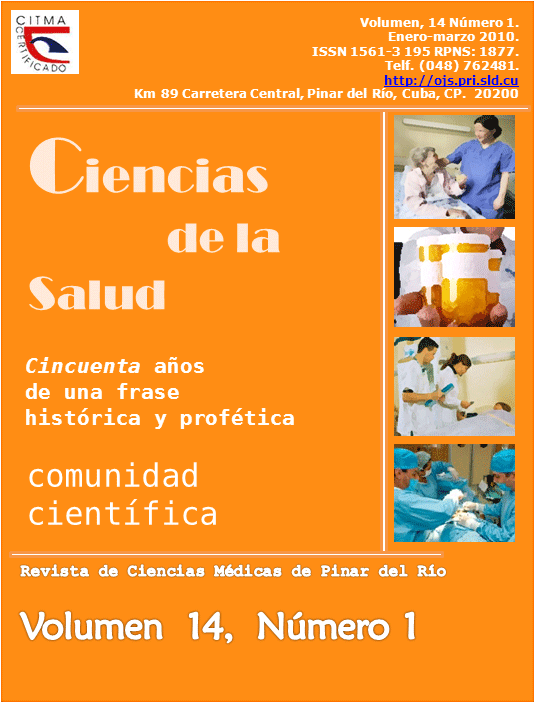Epidemiology of the endometrial lesions in obese women older than 50 years old
Abstract
A retrospective and analytic research was carried out with the purpose of identifying risk factors associated with endometrial lesions in obese women older than 50 years old in Pinar del Rio municipality. The universe was comprised of the total of women living at "Hermanos Cruz" health sector. A group of obese women older than 50 years old and a control group of non-obese women older than 50 years old were chosen. To collect data, a survey-form was used; including general variables of women, personal, familial, gynecological and obstetric records. The survey was applied for both groups having a previous consent. A sonographic study was conducted to women participating in the research and performing an endometrial-histological examination when the Sonography showed abnormalities (greater 4mm in postmenopausal and 14mm in premenopausal women). A database using the variables studied was created; and the results were grouped in charts (simple and of contingency). In the statistical process absolute frequency and percentage, chi square, Fisher's probability test, odds ratio (raw and adjusted), and Z test were used. Obesity was associated with a major probability of having an abnormal sonographic result of the endometrial thickness, premalignant lesions and endometrial cancer; mainly when familial history of breast or colon cancers existed as well as personal records of early menarche, parity and abnormal uterine bleeding.Downloads
References
1. American Cancer Society. Cancer Facts and Figures 2007. Atlanta: American Cáncer Society; 2007.
2. Pérez Echevarria M. Ginecología oncológica pelviana. La Habana: Ciencias Médicas; 2006. Pp. 217-241.
3. Mossa B, Imperato F, Marziani R. Hormonal replacement Therapy and evaluation of intrauterine pathology in postmenopausal women a ten year study.Eur J Gynaecol Oncol 2003 24(6):507-12.
4. Lukanova A, Lundin E, Micheli A. Circulating levels of sex steroidhormones andrisk of endometrial cancer in postmenopausal women. Int J Cancer 2004; 108 (3): 425-32.
5. Persson I, Weiderpass E, Bergkvist L. Risks of breast and endometrial cancer after estrogen and estrogen-progestin replacement. Cancer Causes Control 1999; 10 (4): 253-60.
6. Purdie DM, Green AC. Epidemiology of endometrial cancer. Best Pract Res Clinic Obstet Gynaecol 2001; 15(3):341-54.
7. American Association for Cancer Research. Cancer Epidemiology Biomarkers & Prevention. Journal of Clinical Oncology. 2005; 14 (4): 779-785
8. Love CD, Muir BB, scrimgeouer JB. Investigation of endometrial abnormalities in asymptomatic women treated with tamoxifen and an evaluation of the role of endometrial screening. J Clin Oncol 1999; 17(7): 2050-4.
9. Xu W H , Matthews CE, Xiang YB, Zheng W, Ruan ZX, Cheng JR et al. Effect of Adiposity and Fat Distribution on Endometrial Cancer Risk in Shanghai WomenAm. J Epidemiol 2005; 161(10): 939-7.
10. Polednak AP. Trends in incidence rates for obesity-associated cancers in the U.S. Cancer Detection and Prevention 2003; 27(6):415-421.
11. Calle EE, Rodriguez C, Walker-Thurmond K, Thun MJ. Overweight, obesity, and mortality from cancer in a prospectively studied cohort of U.S. adults. New England Journal of Medicine 2003; 348(17):1625-1638
12. Cuba. Ministerio de Salud Pública. Mortalidad por tumores malignos en el sexo femenino según grupos de edad. Anuario estadístico. La Habana: Ciencias Médicas; 2006.
13. Fleischer AC, Wheeler JE, Lindsay I. An assessment of the value of ultrasonographic screening for endometrial disease in postmenopausal women without symptoms. Am J Obstet Gynecol 2001; 184 (2): 70-5.
14. Gull B, Karlsson B, Milsom I. Can ultrasound replace dilation and curettage? A longitudinal evaluation of postmenopausal bleeding and transvaginal sonographic measurement of the endometrium as predictors of endometrial cancer. Am J Obstet Gynecol 2003; 188 (2): 401-8.
15. Ries LAG, Eisner MP, Kosary CL, et al. SEER Cancer Statistics Review, 1975-2001. Bethesda: National Cancer Institute; 2004.
16. Anderson AB. Diabetes and Endometrial Cancer in the Iowa Women's Health Study. Cancer Epidemiology Biomarkers & Prevention 2001; 10 (6):611-18.
17. Yen-Ching Chen, David J. Hunter. Molecular Epidemiology of Cancer. CA Cancer J Clin [revista en internet],2005 [citado]:55:45-54 Disponible en: http://caonline.amcancersoc.org/cgi/content/abstract/55/1/45
Published
How to Cite
Issue
Section
License
Authors who have publications with this journal agree to the following terms: Authors will retain their copyrights and grant the journal the right of first publication of their work, which will be publication of their work, which will be simultaneously subject to the Creative Commons Attribution License (CC-BY-NC 4.0) that allows third parties to share the work as long as its author and first publication in this journal are indicated.
Authors may adopt other non-exclusive license agreements for distribution of the published version of the work (e.g.: deposit it in an institutional telematic archive or publish it in a volume). Likewise, and according to the recommendations of the Medical Sciences Editorial (ECIMED), authors must declare in each article their contribution according to the CRediT taxonomy (contributor roles). This taxonomy includes 14 roles, which can be used to represent the tasks typically performed by contributors in scientific academic production. It should be consulted in monograph) whenever initial publication in this journal is indicated. Authors are allowed and encouraged to disseminate their work through the Internet (e.g., in institutional telematic archives or on their web page) before and during the submission process, which may produce interesting exchanges and increase citations of the published work. (See The effect of open access). https://casrai.org/credit/



